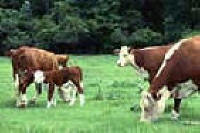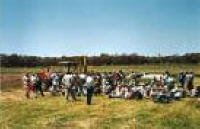

To send a message to an author, click on the author's name at the end of the article.
This Month in Ag Connection | Ag Connection - Other Issues Online
Sudangrass, sorghum-sudangrass hybrids and pearlmillet are warm-season annual forages that you may want to consider for either hay production or grazing. These forages can be seeded from early May through mid-June. The following key management points are taken from MU Guide G4661, "Warm Season Annual Crops".
After frost damage or drought stress, sorghum-sudangrass should not be grazed for 14 days or until there is 24 inches of regrowth. This helps to avoid prussic acid poisoning. Prussic acid dissipates during hay curing or ensiling, so forage harvested at the proper height or stored 10 to 14 days should not present a problem.
The guidesheet contains several other details regarding the specific management of these forages. The guidesheet is available at your local Extension office or on the Internet at http://extension.missouri.edu/publications/DisplayPub.aspx?P=G4661.
More information is also available from your regional agronomy or livestock specialists.
(Author: Gene Schmitz, Livestock Specialist)
This Month in Ag Connection | Ag Connection - Other Issues Online
Soybean rust in 2005 did not live up to its feared potential, but did provide opportunities to observe the disease and learn more about how it may perform in the United States. Scientists were surprised in 2005 at the lack of soybean rust movement after the widespread discoveries in the southeastern states in November and December 2004. In 2005, wind direction generally was not favorable for spreading spores north. More winds in May through August moved from west to east, not north. Most of the soybean rust activity was confined to the Gulf Coast areas of Alabama, Florida, Georgia and southeast Mississippi until it began spreading north into Georgia in August. By September, rust had spread across Georgia and into the Carolinas and, by the end of the year, moved west to Louisiana and Texas. The rust movement was much less than expected.
Researchers believe they have found some answers as to why rust spread slowly in 2005. Kudzu was expected to be the "bell cow" that would tip off researchers to the movement of rust in the southeast and Delta states. The U.S. version of soybean rust appears to develop more slowly than anticipated on kudzu. Another possible limitation on the spread of rust in 2005 was drought barrier. There was a record or near record drought from Texas through the Delta to the central Midwest and into the Ohio Valley. Rick Cartwright, an Arkansas Extension plant pathologist, believes that the curve of the drought hemmed Asian Soybean Rust (ASR) into the southeast where rainfall was at a more normal level. In 2005, researchers also learned that conditions in the United States are not as favorable for ASR as those in Brazil. During a drought year, the rust does not appear to be a major issue for our soybean crop. Brazil has more rain, and more rain consistently, during the growing seasons than we do. Temperatures ranging from 66 to 80 degrees F are ideal for soybean rust, while temperatures above 86 degrees F may retard disease development.
Record warm temperatures this past winter probably contributed to the increased findings of Asian soybean rust in Alabama, Florida, Georgia and Texas earlier this year. This increased survival of the disease increases the chance for the disease to move into the critical regions of Louisiana and Mississippi and thus we are likely to see more activity this spring in the south. After a flurry of confirmed Asian soybean rust findings in January and February, no new findings have been reported since the first week of March.
The long range forecast is for the Midwest states to have normal rainfall this spring and into the summer. If that forecast pans out, those states would have a lower probability of a soybean rust epidemic, because normal rainfall does not normally mean abundant rainfall for those states according to X.B.Yang, Extension plant pathologist from Iowa State University. He indicates that even if we have a lot of spores blown into the area, the risk of an outbreak is not very high because the normal rainfall would not be favorable for rust development. Yang also stated that it is too early to determine if soybean rust will or will not be a problem for the northern soybean production region. We are not out of the woods yet and need to be vigilant. Asian soybean rust is manageable.
To be prepared for the 2006 growing season:
Check the following Missouri web site for information from sentinel plots. http://agebb.missouri.edu/mgt/soyrust/index.htm
(Author: Wayne Crook, Agronomy Specialist)
This Month in Ag Connection | Ag Connection - Other Issues Online

QSA is a voluntary age and source verification program. At last week's World Meat Congress in Australia, Gary Johnson, McDonald's Corporation Senior Director of Worldwide Supply Chain Management, asked for traceability of beef cattle.
According to Johnson, animal traceability is the number one way to maintain consumer trust in food safety. Johnson believes the cost associated with implementing a traceability program is a "down payment" on consumer trust and will pay dividends in the future.
Contact your extension livestock specialist or your veterinarian for more information. Information can also be found on the web at: http://www.mda.mo.gov/qsa/index.html
(Source: Drover's Alert by Drover's Journal)
This Month in Ag Connection | Ag Connection - Other Issues Online
The University of Missouri Food and Agricultural Policy Research Institute's (FAPRI) March 2006 10-year baseline report projects increasing costs and narrow farm profit margins. Farm production expenses have increased $28 billion (14.6%) in the last three years and are expected to jump another $7 billion (3%) in 2006. Fuel and energy costs account for $10 billion of the increase since 2002, but other costs such as feed, purchased livestock, seed, repairs and interest also have increased substantially. The baseline report projects total net U.S. farm income to be $56 billion in 2006, well below 2004's record $82.5 billion. The cost-price pressures are expected to continue. Net farm income is projected to fall to $52 billion in 2007 then slowly rise to $58 billion by 2010.
Back-to-back record soybean yields have contributed to record soybean carryover supplies. These large carryovers, coupled with record world supplies and increased 2006 U.S. soybean planted acreage that will add to burdensome supplies, is expected to pressure prices. Soybean prices that are expected to average $5.60 in 2005-06 and could be substantially lower in 2006-07, assuming average or above average yields in South America and the United States. Continuing strong demand and fewer acres in following years suggest prices recovering somewhat to the mid or upper $5.00 range throughout most of the remainder of the baseline estimates.
Record corn production in 2004 and surprising yields in 2005 have resulted in the two largest production years ever. Higher production costs, lower prices, and a return to trendline yields point to declines in corn net returns for 2006-07. Corn acreage is expected to decline in 2006, then increase in 2007 and succeeding years. Corn use is projected to continue growing, especially for corn used for ethanol production. Ethanol use is expected to increase from 2.0 billion bushels in 2006 to more than 2.8 billion bushels by 2014. Corn prices are projected to range from $2.20 in 2006-07 to near $2.50 throughout the baseline.
Harvested wheat acreage in the Southern Plains is expected to decline and wheat prices are projected to remain relatively stable, near $3.40 per bushel during the next three years.
With increased meat production and uncertain meat exports, livestock prices increasingly depend on domestic demand. Resumptions of beef exports to Japan and the possibility of avian flu are wild cards in livestock price forecasts.
The beef herd, stimulated by higher beef prices since 2003, is projected to expand and peak at more than 103 million head by 2012. As beef supplies increase, prices are expected to moderate. A 600-pound feeder calf that brought $120 per cwt. in 2005 is projected to be near $84 per cwt. by 2012. Fed cattle in Nebraska are forecast to drop from $87 per cwt. to $71 in 2012.
In spite of a fifth year of record pork production, hog prices remained near $50 per cwt. in 2005. However, as pork supplies continue to grow and exports are expected to slow, hog prices are expected to slip to $40 per cwt. by 2007.
High milk prices in 2004-05 encouraged increased production, and as a result milk supplies are expected to outpace demand. Prices are expected to drop from the $15 per cwt. of the past two years to $13.49 in 2006.
The complete FAPRI 2006 baseline and other outlook reports are available at: http://www.fapri.missouri.edu/
(Authors: Melvin Brees, Scott Brown, Pat Westhoff, FAPRI)
This Month in Ag Connection | Ag Connection - Other Issues Online
The latest in crop, livestock, forage, horticultural, wildlife and agroforestry research will be on display at field days conducted at University of Missouri research centers and farms this summer.
Among the beef and grazing-related events are:

June 15-16
Grazing School
Wurdack Farm
Cook Station
John Poehlmann
(573) 882-4450
June 23
Native Plant Field Day
Bradford Research and Extension Center
Columbia
Tim Reinbott
(573) 884-7945
July 12
Weed/Integrated Pest Management Field Day
Bradford Center
Columbia, MO.
Tim Reinbott
(573) 884-7945
August 26
Bobwhite Quail Management Workshop and Field Day
Bradford Center
Columbia
Tim Reinbott
(573) 884-7945
September 26-28
Beginning Grazing School
Forage Systems Research Center
Linneus
David Davis
(660) 895-5121
This Month in Ag Connection | Ag Connection - Other Issues Online
10. Cash Method Reporting
9. Weather-Related Sales
8. Installment Sales
7. Income Averaging
6. Exclusion of Gain on Sale of Residence
5. Special Land Use Valuation
4. Soil and Water Conservation Expensing
3. Step-Up in Basis for Estate Assets
2. Like-Kind Exchanges
1. Section 179 Capital Expensing
For more information, see: http://agebb.missouri.edu/agtax/index.htm
(Author: Parman R. Green, Ag Business Mgmt. Specialist)
This Month in Ag Connection | Ag Connection - Other Issues Online
Publishing Information
Ag Connection is published monthly for Northeast and Central areas of Missouri producers and is supported by the University of Missouri Extension, the Missouri Agricultural Experiment Station, and the MU College of Agriculture, Food and Natural Resources. Managing Editor: Mary Sobba.